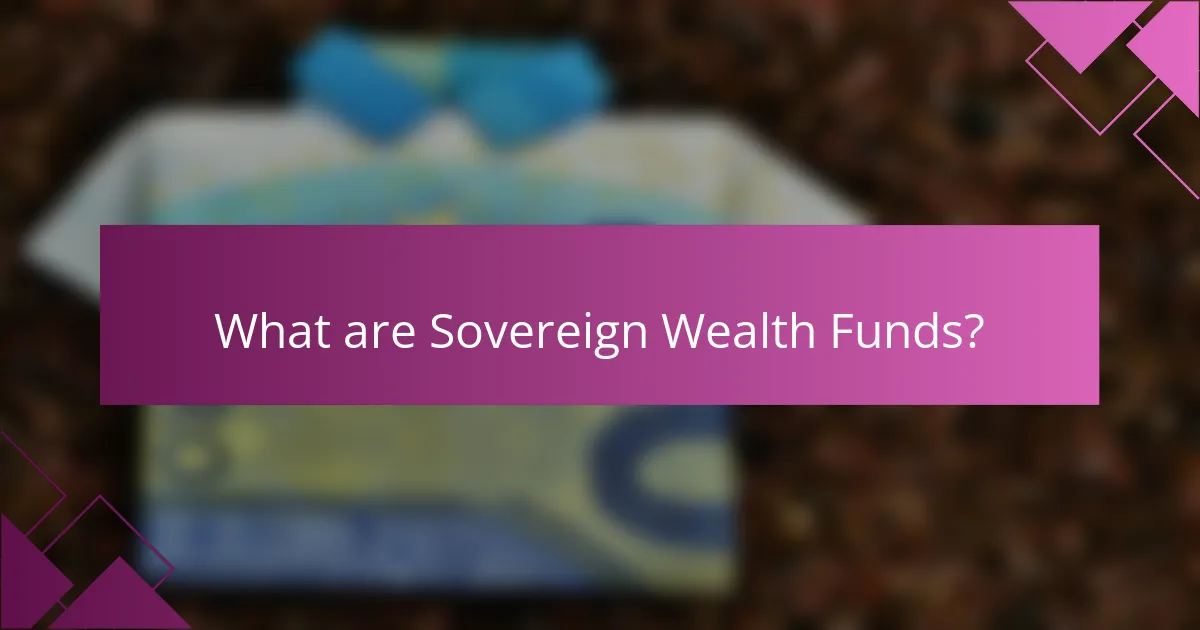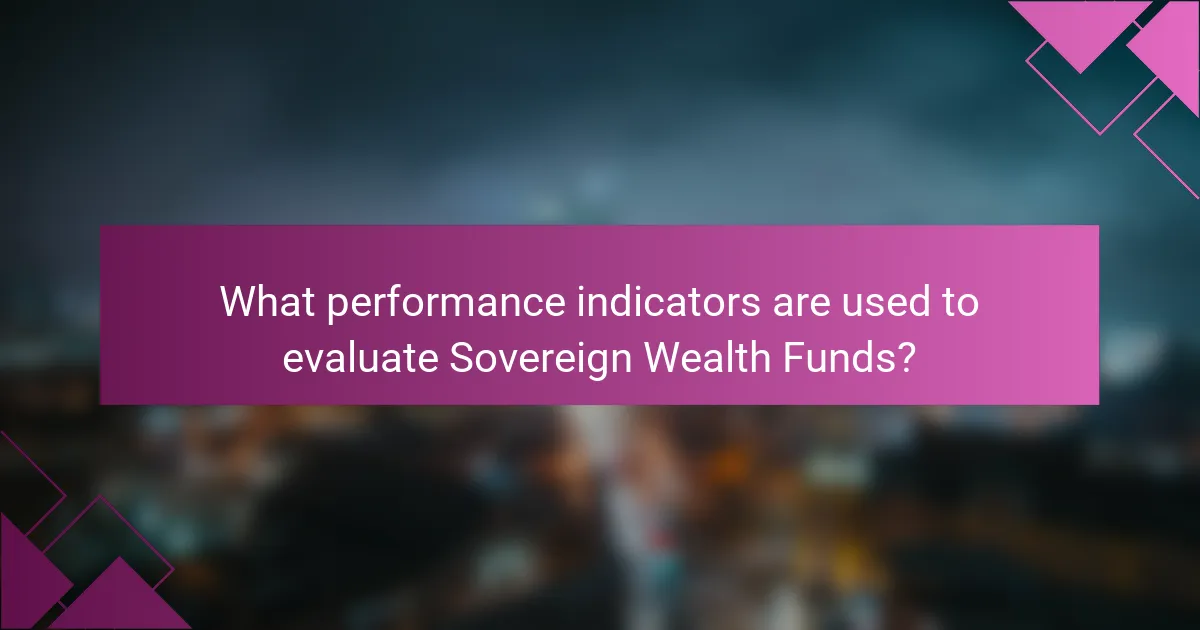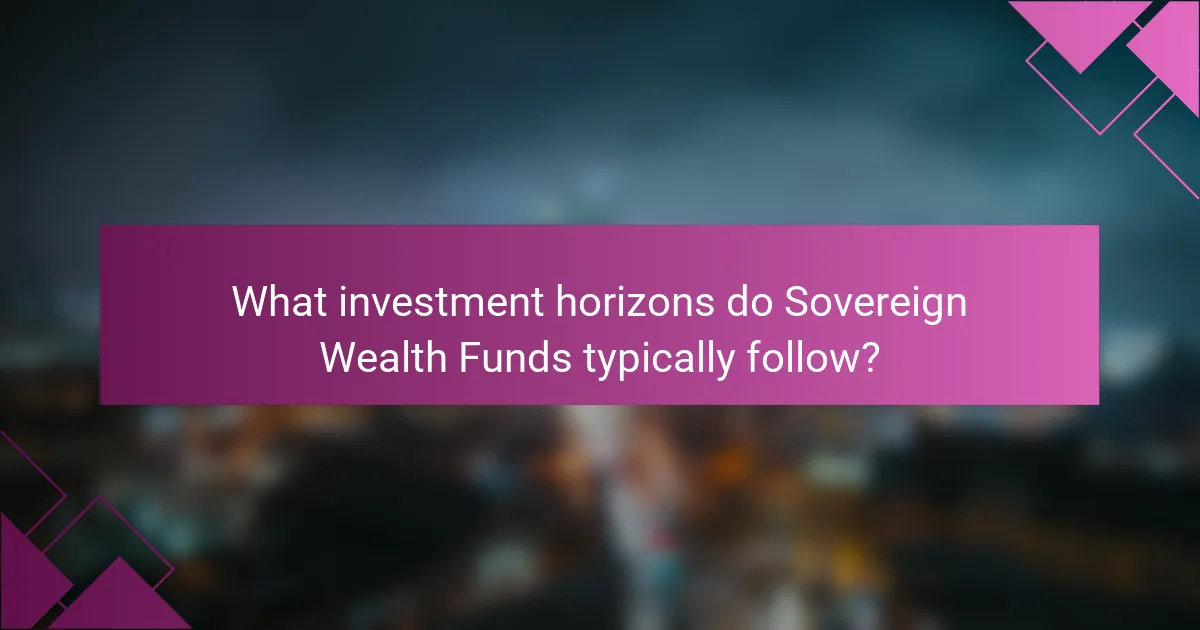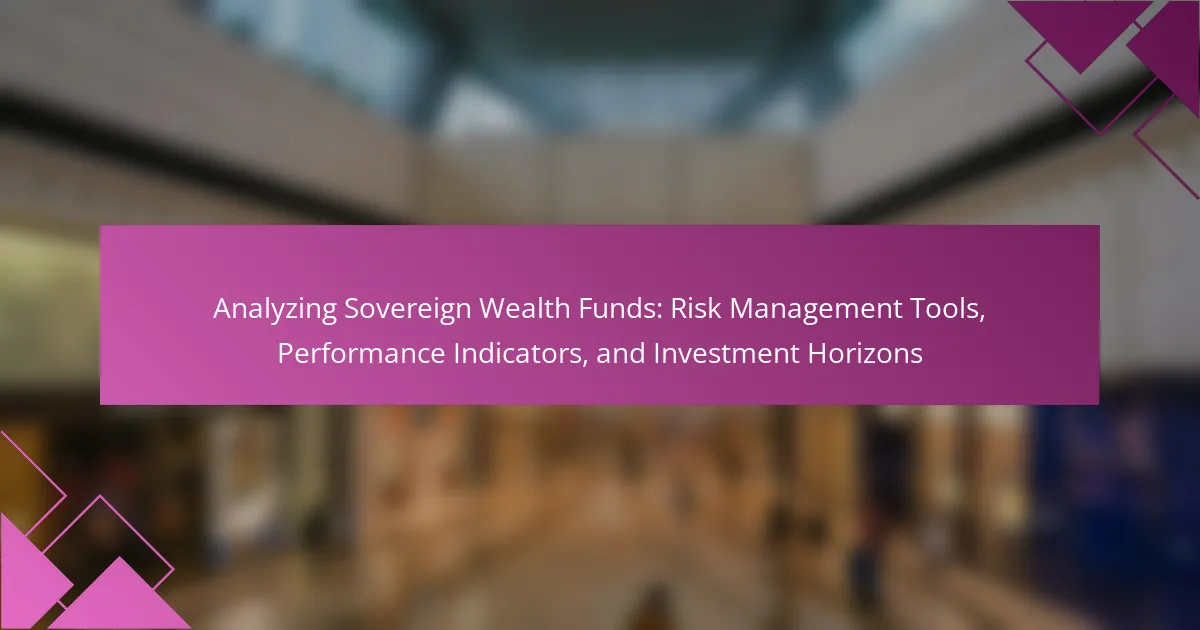
What are Sovereign Wealth Funds?
Sovereign Wealth Funds (SWFs) are state-owned investment funds or entities. They are used to manage a country’s reserves for various purposes. These funds invest in a wide range of assets, including stocks, bonds, real estate, and commodities. SWFs aim to achieve long-term financial returns for the benefit of the country’s economy. They often originate from surplus revenues, such as those from natural resources. For example, Norway’s Government Pension Fund Global is one of the largest SWFs, managing over $1 trillion in assets. SWFs can also play a role in stabilizing national economies during financial crises.
How do Sovereign Wealth Funds operate?
Sovereign Wealth Funds (SWFs) operate by managing national savings for the purpose of investment. They are state-owned investment funds or entities. These funds invest in a variety of assets, including stocks, bonds, real estate, and commodities. SWFs aim to achieve long-term financial returns for their countries. They are often funded by surplus revenues from natural resources or fiscal surpluses. The investment strategies of SWFs can vary widely, depending on their goals and risk tolerance. For example, some may focus on high-risk, high-return investments, while others may prioritize stability and income generation. SWFs are typically governed by specific investment policies and mandates set by their respective governments.
What types of assets do Sovereign Wealth Funds typically hold?
Sovereign Wealth Funds typically hold a diverse range of assets. These assets include equities, fixed income securities, real estate, and alternative investments. Equities represent ownership in companies and provide potential for capital appreciation. Fixed income securities, such as bonds, offer regular interest payments and lower risk. Real estate investments can generate rental income and long-term value appreciation. Alternative investments may include private equity, hedge funds, and commodities, which provide diversification and potential high returns. Sovereign Wealth Funds aim to balance risk and return through this asset allocation strategy.
What are the primary objectives of Sovereign Wealth Funds?
The primary objectives of Sovereign Wealth Funds (SWFs) include stabilizing the economy, saving for future generations, and diversifying investments. SWFs aim to manage national savings and surplus revenues effectively. They often invest in various asset classes to mitigate risks associated with economic fluctuations. For instance, during economic downturns, SWFs can provide financial support to stabilize national budgets. Additionally, they seek to generate long-term returns on investments. By investing in global markets, SWFs enhance their portfolio diversification. This strategy helps reduce reliance on domestic revenues. According to the International Forum of Sovereign Wealth Funds, these funds play a crucial role in economic stability and growth.
What is the significance of Sovereign Wealth Funds in the global economy?
Sovereign Wealth Funds (SWFs) play a crucial role in the global economy by providing capital for investments and stabilizing national economies. They are state-owned investment funds that manage national savings for various purposes, including economic diversification and wealth generation. SWFs help stabilize economies during financial crises by providing liquidity and supporting local markets. As of 2023, the total assets managed by SWFs are estimated to exceed $10 trillion, highlighting their significant economic influence. They invest in various asset classes, including equities, bonds, real estate, and infrastructure. This diversification helps mitigate risks and enhance returns. Additionally, SWFs often invest in foreign markets, promoting global economic interdependence. Their investments can lead to job creation and infrastructure development in host countries. Overall, SWFs are vital for economic stability, growth, and global financial integration.
How do Sovereign Wealth Funds influence financial markets?
Sovereign Wealth Funds (SWFs) influence financial markets by acting as large institutional investors. They manage substantial assets, often exceeding hundreds of billions of dollars. Their investment decisions can significantly impact asset prices and market liquidity. For instance, SWFs typically invest in equities, bonds, and real estate globally. This can lead to increased demand for these assets, driving up their prices.
Moreover, SWFs often have a long-term investment horizon. This approach can stabilize markets during periods of volatility. Their presence can encourage other investors to participate, boosting overall market confidence. According to the Sovereign Wealth Fund Institute, SWFs collectively manage over $10 trillion in assets, underscoring their market influence.
Additionally, SWFs can engage in strategic investments that promote economic development in their home countries. This can lead to enhanced market stability and growth prospects. Overall, the influence of SWFs on financial markets is profound, shaping investment trends and market dynamics.
What role do Sovereign Wealth Funds play in national economic stability?
Sovereign Wealth Funds (SWFs) play a crucial role in national economic stability by providing a buffer against economic shocks. They are state-owned investment funds that manage national savings for various purposes, including stabilization and economic development. SWFs can help stabilize a nation’s economy by diversifying revenue sources, particularly in resource-dependent countries. For example, during economic downturns, SWFs can be tapped to support government budgets and maintain public services.
Additionally, SWFs invest in a range of asset classes, which can yield returns that contribute to national wealth. According to the International Monetary Fund, SWFs have grown significantly, with total assets exceeding $10 trillion globally. This growth underscores their importance as tools for mitigating volatility in national economies. By investing in foreign assets, SWFs also help balance the trade deficit and strengthen the national currency. Thus, SWFs are integral to promoting long-term economic stability and resilience.

What risk management tools are utilized by Sovereign Wealth Funds?
Sovereign Wealth Funds utilize various risk management tools to mitigate financial risks. These tools include diversification strategies, which spread investments across asset classes and geographies. They also employ asset-liability management to align their investment strategies with future liabilities. Stress testing is another tool used to assess the impact of extreme market conditions on their portfolios.
Additionally, Sovereign Wealth Funds often use hedging techniques, such as derivatives, to protect against currency and interest rate fluctuations. Risk assessment frameworks are implemented to evaluate and monitor investment risks continuously. Furthermore, they may utilize risk management software for real-time analytics and reporting.
These tools collectively enhance the resilience of Sovereign Wealth Funds against market volatility and economic uncertainties.
How do Sovereign Wealth Funds assess and mitigate investment risks?
Sovereign Wealth Funds assess and mitigate investment risks through a combination of strategies. They conduct thorough due diligence before making investments. This includes analyzing market conditions, financial statements, and geopolitical factors. They also diversify their investment portfolios across various asset classes and geographic regions. Diversification helps reduce exposure to any single investment risk. Additionally, they employ risk management frameworks to identify and evaluate potential risks. These frameworks often include stress testing and scenario analysis. Sovereign Wealth Funds also monitor investments continuously to adjust strategies as needed. According to the International Forum of Sovereign Wealth Funds, effective risk management is crucial for long-term performance.
What are the common risk management strategies employed?
Common risk management strategies employed include diversification, hedging, and asset allocation. Diversification spreads investments across various asset classes to reduce exposure to any single risk. Hedging uses financial instruments to offset potential losses in investments. Asset allocation involves distributing investments among different categories to optimize risk and return. These strategies help mitigate risks associated with market volatility and economic fluctuations. According to the International Monetary Fund, effective risk management is crucial for the sustainability of sovereign wealth funds.
How do Sovereign Wealth Funds use diversification as a risk management tool?
Sovereign Wealth Funds use diversification to mitigate investment risks. By spreading investments across various asset classes, they reduce exposure to any single economic event. This strategy includes allocating funds to equities, bonds, real estate, and commodities. Diversification helps stabilize returns over time. For example, during market downturns, losses in one asset class can be offset by gains in another. Studies show that diversified portfolios tend to perform better in volatile markets. Additionally, Sovereign Wealth Funds often invest in different geographical regions to further minimize risks. This global approach enhances their resilience against localized economic downturns.
What technologies support risk management in Sovereign Wealth Funds?
Technologies that support risk management in Sovereign Wealth Funds include advanced analytics, artificial intelligence, and machine learning. These technologies enhance data processing capabilities. They allow for real-time risk assessment and predictive modeling. Risk management software also plays a critical role. It provides tools for scenario analysis and stress testing. Blockchain technology improves transparency and security in transactions. Additionally, data visualization tools help in interpreting complex data sets. These technologies collectively enhance decision-making processes in risk management.
How do data analytics improve risk assessment?
Data analytics improves risk assessment by enabling organizations to analyze large datasets for identifying potential risks. It facilitates the detection of patterns and trends that may not be visible through traditional methods. Predictive analytics can forecast future risks based on historical data. This allows organizations to proactively manage and mitigate risks before they escalate. Additionally, data analytics enhances decision-making by providing data-driven insights. According to a report by Deloitte, organizations that leverage analytics can reduce risk-related costs by up to 30%. This demonstrates the tangible benefits of integrating data analytics into risk assessment processes.
What role does artificial intelligence play in risk management?
Artificial intelligence enhances risk management by improving data analysis and decision-making processes. It identifies patterns in large datasets that humans may overlook. AI algorithms can predict potential risks through historical data analysis. This predictive capability allows for proactive risk mitigation strategies. For instance, machine learning models can assess market volatility and economic indicators in real time. According to a report by McKinsey, organizations using AI in risk management have seen a 20-30% reduction in losses. AI also automates routine risk assessments, increasing efficiency and accuracy. Overall, AI transforms risk management into a more dynamic and responsive discipline.

What performance indicators are used to evaluate Sovereign Wealth Funds?
Sovereign Wealth Funds (SWFs) are evaluated using several key performance indicators. Common indicators include return on investment (ROI), which measures the profitability of the fund. Another important indicator is the Sharpe ratio, assessing risk-adjusted returns. The information ratio evaluates the excess return relative to the risk taken. Additionally, the tracking error measures the deviation of the fund’s returns from a benchmark index. Net asset value (NAV) reflects the total value of the fund’s assets minus liabilities. Lastly, liquidity ratios indicate the fund’s ability to meet short-term obligations. These indicators provide a comprehensive view of the fund’s performance and risk profile.
How do Sovereign Wealth Funds measure their investment performance?
Sovereign Wealth Funds measure their investment performance primarily through benchmarks and performance indicators. They often use market indices as benchmarks to compare returns. This allows for an assessment of how well the fund is performing relative to the market. Additionally, they analyze risk-adjusted returns to account for the level of risk taken to achieve those returns. Common metrics include the Sharpe ratio and the Information ratio. These metrics help in understanding the efficiency of investment strategies. Sovereign Wealth Funds also evaluate performance over various time horizons, such as short-term and long-term periods. This comprehensive approach ensures a detailed analysis of investment effectiveness.
What are the key performance metrics for Sovereign Wealth Funds?
The key performance metrics for Sovereign Wealth Funds include total return, risk-adjusted return, and benchmark comparison. Total return measures the overall gain or loss generated by the fund, including income and capital appreciation. Risk-adjusted return evaluates performance relative to the risk taken, often using metrics like Sharpe ratio. Benchmark comparison assesses how the fund performs against a relevant index or peer group. Additional metrics may include liquidity ratios, cost efficiency, and asset allocation effectiveness. These metrics provide insights into the fund’s operational efficiency and investment success.
How do benchmarks affect the evaluation of Sovereign Wealth Fund performance?
Benchmarks significantly influence the evaluation of Sovereign Wealth Fund performance. They serve as a standard for comparison, allowing fund managers to assess investment returns relative to market averages or specific indices. This comparison aids in identifying whether the fund is underperforming or outperforming its peers. For instance, if a Sovereign Wealth Fund consistently lags behind its benchmark, it may indicate poor management or investment strategy. Furthermore, benchmarks help in setting performance targets and expectations for stakeholders. By providing a clear metric, they facilitate accountability and transparency within the fund’s operations. Ultimately, the proper use of benchmarks can enhance decision-making processes and optimize investment strategies.
What challenges exist in measuring the performance of Sovereign Wealth Funds?
Measuring the performance of Sovereign Wealth Funds (SWFs) presents several challenges. One challenge is the lack of standardized benchmarks. Different SWFs have varying investment strategies and objectives, making comparison difficult. Additionally, the long-term investment horizon of many SWFs complicates performance measurement. Short-term fluctuations may not accurately reflect their overall success.
Another challenge is the opacity of some SWFs. Limited transparency can hinder the assessment of their performance metrics. Furthermore, political and economic factors can influence returns, adding complexity to the evaluation process.
Lastly, the diverse asset classes held by SWFs can complicate performance calculations. Valuation methods may differ across assets, leading to inconsistencies in reported performance. These challenges collectively make it difficult to assess the true performance of Sovereign Wealth Funds accurately.
How do external economic factors impact performance indicators?
External economic factors significantly impact performance indicators. These factors include inflation rates, interest rates, and economic growth. For example, high inflation can erode purchasing power, affecting revenue and profitability. Changes in interest rates influence borrowing costs and investment decisions. Economic growth leads to increased demand for goods and services, boosting performance metrics. Conversely, economic downturns can lead to reduced revenues and lower performance indicators. Historical data shows that during the 2008 financial crisis, many performance indicators for sovereign wealth funds dropped significantly due to external economic pressures.
What limitations are associated with traditional performance metrics?
Traditional performance metrics have several limitations. They often focus on historical data, which may not predict future performance accurately. They can oversimplify complex investment strategies, failing to capture nuances. Additionally, traditional metrics may encourage short-term thinking over long-term value creation. They frequently do not account for risk-adjusted returns, leading to potentially misleading conclusions. Furthermore, these metrics may lack context regarding market conditions and economic factors. This can result in an incomplete assessment of performance. Lastly, reliance on traditional metrics can hinder innovation in investment strategies.

What investment horizons do Sovereign Wealth Funds typically follow?
Sovereign Wealth Funds typically follow long-term investment horizons. These funds are designed to manage national savings for future generations. Their investment strategies often span 10 to 20 years or more. This allows for the absorption of market volatility. Long-term horizons enable them to invest in illiquid assets. Examples include real estate and infrastructure projects. The focus on long-term growth aligns with their mandate to preserve wealth. Historical data shows that long-term investments generally yield higher returns. This strategy is supported by the need for stability and sustainability in national finances.
How do investment horizons influence the strategies of Sovereign Wealth Funds?
Investment horizons significantly influence the strategies of Sovereign Wealth Funds (SWFs). Short-term horizons often lead to a focus on liquidity and capital preservation. This is crucial during market volatility, as SWFs may prioritize less risky assets. In contrast, long-term horizons enable SWFs to pursue growth-oriented investments. These investments can include equities and alternative assets that may yield higher returns over time.
For example, according to the International Monetary Fund, SWFs with longer investment horizons tend to allocate more capital to illiquid assets. This strategy allows them to benefit from potential appreciation over extended periods. Additionally, investment horizons affect asset allocation decisions. SWFs with shorter horizons may diversify their portfolios to mitigate risks.
On the other hand, those with longer horizons can concentrate on fewer investments. This approach can enhance returns but also increases exposure to specific market risks. Overall, the investment horizon shapes the risk tolerance and asset selection of Sovereign Wealth Funds.
What are the differences between short-term and long-term investment horizons?
Short-term investment horizons typically span from a few days to a few years. They focus on quick returns and liquidity. Investors often seek to capitalize on market fluctuations. Common instruments include stocks, bonds, and money market funds.
Long-term investment horizons extend beyond several years, often 5 to 10 years or more. They aim for substantial growth over time. Investors usually prioritize stability and compound returns. Common instruments include real estate, mutual funds, and retirement accounts.
The primary difference lies in the time frame and risk tolerance. Short-term investments carry higher volatility, while long-term investments are generally less susceptible to market swings. According to a study by the CFA Institute, long-term investors often achieve better returns due to the effects of compounding and market recovery over time.
How do market conditions affect investment horizon decisions?
Market conditions significantly influence investment horizon decisions. When market volatility is high, investors may prefer shorter horizons to mitigate risks. Conversely, stable market conditions often encourage longer investment horizons. Economic indicators, such as interest rates and inflation, also play a crucial role. For instance, low interest rates can lead to longer horizons as borrowing costs decrease. Historical data shows that during economic downturns, like the 2008 financial crisis, many investors shortened their horizons. This shift reflects a desire for liquidity and risk aversion in uncertain environments. Hence, understanding market conditions is essential for making informed investment horizon decisions.
What best practices can be adopted for effective investment horizon management?
Effective investment horizon management involves aligning investment strategies with time frames. Investors should define their goals clearly. Understanding the risk tolerance is crucial for setting appropriate horizons. Regularly reviewing and adjusting the investment portfolio is necessary to stay aligned with market conditions. Diversifying investments across asset classes can mitigate risks associated with different time frames. Utilizing performance indicators helps in assessing the effectiveness of the investment strategy. Historical data analysis supports informed decision-making regarding future investments. Implementing a disciplined approach ensures consistency in managing investment horizons.
How can Sovereign Wealth Funds align their investment horizons with national interests?
Sovereign Wealth Funds can align their investment horizons with national interests by adopting long-term strategies that reflect a country’s economic goals. These funds should prioritize investments in sectors that promote national development, such as infrastructure and technology. By focusing on sustainable projects, they can ensure economic stability and growth. Additionally, engaging with local stakeholders helps to understand community needs and align investments accordingly. Transparency in investment decisions builds public trust and supports national priorities. Countries like Norway have successfully aligned their Sovereign Wealth Fund with national interests through responsible investment practices. This approach not only benefits the fund but also enhances overall national welfare.
What strategies can enhance the adaptability of investment horizons?
Diversification of asset allocation can enhance the adaptability of investment horizons. By spreading investments across various asset classes, funds can mitigate risks associated with market volatility. Research shows that a diversified portfolio can improve returns over different time frames. Regularly rebalancing the portfolio helps maintain the desired risk level and investment strategy. Incorporating flexible investment strategies, such as dynamic asset allocation, allows funds to adjust to changing market conditions. Additionally, utilizing scenario analysis can prepare funds for various economic outcomes. This adaptability is crucial for managing long-term investment goals effectively.
What are the future trends in Sovereign Wealth Fund management?
Future trends in Sovereign Wealth Fund management include increased focus on sustainability and responsible investing. Many funds are integrating environmental, social, and governance (ESG) criteria into their investment strategies. This shift aligns with global efforts to combat climate change and promote social equity. Additionally, there is a growing trend towards diversification of asset classes. Sovereign Wealth Funds are looking beyond traditional equities and bonds to include alternative investments such as real estate and infrastructure. Technological advancements are also influencing fund management. The use of data analytics and artificial intelligence is enhancing decision-making processes. Furthermore, collaboration among funds is on the rise. Sharing insights and best practices can lead to improved performance and risk management. These trends reflect a broader evolution in investment strategies to adapt to changing economic and social landscapes.
How are emerging markets influencing Sovereign Wealth Fund strategies?
Emerging markets are significantly influencing Sovereign Wealth Fund (SWF) strategies. SWFs are increasingly allocating capital to these markets due to their high growth potential. For instance, emerging markets are expected to contribute over 60% of global GDP growth by 2025. This trend encourages SWFs to diversify their portfolios and seek higher returns. Additionally, emerging markets often present unique investment opportunities in infrastructure and technology sectors. The volatility associated with these markets also prompts SWFs to adopt more sophisticated risk management tools. As a result, SWFs are adjusting their investment horizons to align with the long-term growth trajectories of emerging economies. This strategic shift reflects a broader recognition of the economic significance of these regions in the global landscape.
What innovations are shaping the future of Sovereign Wealth Funds?
Innovations shaping the future of Sovereign Wealth Funds include advanced data analytics, artificial intelligence, and sustainable investing strategies. Advanced data analytics enables funds to make informed investment decisions based on real-time market data. Artificial intelligence enhances risk assessment and portfolio management by identifying patterns and predicting market trends. Sustainable investing strategies focus on environmental, social, and governance (ESG) criteria, aligning investments with global sustainability goals. These innovations are driven by the need for transparency and accountability in fund management. The adoption of blockchain technology is also emerging, providing secure and efficient transaction processes. Collectively, these innovations are transforming how Sovereign Wealth Funds operate and invest.
Sovereign Wealth Funds (SWFs) are state-owned investment entities that manage national savings for various purposes, including economic stabilization and long-term financial returns. This article analyzes the risk management tools utilized by SWFs, performance indicators for evaluating their effectiveness, and the impact of investment horizons on their strategies. Key aspects include the diverse asset classes held by SWFs, the significance of benchmarks in performance evaluation, and the challenges faced in measuring their success. Additionally, emerging trends in SWF management, such as sustainable investing and technological innovations, are explored to highlight the evolving landscape of these influential financial entities.
